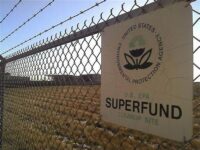
Is Loper Bright a Red Herring? Why Ohio v. EPA Could Be Dangerous for Environmental Federal Agencies
By Christina Karem & Laurie Beyranevand
The 2024 term of the United States Supreme Court resulted in historic rulings affecting a variety of hot-press issues. Notably, this term reshaped administrative law and regulatory agencies in unprecedented ways. With the overturning of Chevron deference and the narrowing of rulemaking authority, regulatory agencies and regulated entities are scrambling to understand how two landmark cases will affect the enforcement and implementation of federal statutes.
One of the two consequential rulings was Loper Bright Enterprises v. Raimondo (Loper Bright), which overturned Chevron deference—a doctrine courts used to defer to agency’s reasonable statutory interpretation in the face of ambiguity. Another opinion that received less attention is Ohio v. Environmental Protection Agency (Ohio v. EPA). In Ohio v. EPA, the Court addressed the question of whether the EPA’s “good neighbor” rule, which is meant to limit transboundary pollution, should be stayed pending the outcome of a challenge by several states, industry groups, and others who argued the rule was arbitrary and capricious. While Loper Bright dismantles the Chevron deference framework, Ohio v. EPA goes a step further by questioning the validity of substantive regulatory decisions, raising concerns about the future of effective environmental governance.
This article argues that while Loper Bright captured the nation’s attention regarding administrative law, the threat posed by the Ohio v. EPA decision warrants serious attention. Language in the Court’s opinion suggests a return to a stricter version of hard look review that could challenge the expert-based substantive decision-making of federal regulatory agencies through judicial review. For environmental agencies like the EPA, this judicial development could hinder their ability to make science-based, expert-informed decisions in the face of pressing environmental challenges.
The Cases: What Happened and What Does It Mean?
In Loper Bright, the Supreme Court overruled Chevron v. Natural Resource Defense Council (1984). The Court held that the Administrative Procedure Act (APA) requires courts to exercise their own judgement on whether federal agencies have acted within their statutory authority. The courts should no longer defer to agency interpretation in the face of ambiguity—opposite Chevron deference.
Chevron deference was a two-part test courts employed when reviewing agency statutory interpretation. First, a reviewing court was to determine whether Congress had directly spoken to the question at issue. If congressional intent was clear, the judicial analysis was complete and the clear statutory language should be followed. But if congressional intent was ambiguous or silent, the courts were to defer to the agency’s reasonable interpretation. Should the courts determine the agency’s interpretation was not reasonable, the courts would disallow the agency’s interpretation.
Loper Bright expressly overruled Chevron. With this opinion, the Court established a ‘best interpretation’ standard—courts should use all statutory interpretation tools at their disposal to determine the best reading of a statute and resolve ambiguity, rather than deferring to the agency’s permissible construction. The Court emphasized the judiciary’s responsibility to determine statutory meaning, rather than the agency. This shift fundamentally alters how courts have approached these questions since Chevron by removing the long-standing presumption of agency ability to resolve unclear legislative mandates. The Court also highlights the lack of agency expertise in resolving statutory ambiguity, suggesting that they are not situated to understand how to interpret statutes despite their role administering, implementing, and enforcing often complex regulatory schemes. They point to the Framers’ anticipation that courts would resolve statutory ambiguities because that is the job of the judiciary—to interpret statutes. Loper did not say that courts cannot agree with agencies’ interpretations or give them a certain amount of respect, but they can no longer claim Chevron deference applies in the face of statutory ambiguity. While an important case for administrative law, Loper Bright mainly affects how agencies interpret statutes and would not interfere with their substantive expert policy decisions—but this case is not working against federal agencies alone.
In Ohio v. EPA, the Supreme Court found that it was likely that the EPA’s ‘Good Neighbor’ rule was arbitrary and capricious, issuing a stay on the rule. The petitioners included a group of states for which EPA rejected implementation plans to reduce emissions and imposed a Federal Implementation Plan (FIP) on them. They argued the underlying regulation was arbitrary and capricious because the EPA failed to adequately consider comments submitted during the public comment period. Specifically, Petitioners requested an explanation of why a rule that was originally applicable to 23 states should maintain the same emission standards for only 12 states. EPA responded by saying the requirements placed on each state were severable and the rule could function regardless of the number of states involved. However, the Court held that Petitioners were likely to succeed on the merits of their argument that EPA acted arbitrarily and capriciously. When a court finds an agency acted in an arbitrary and capricious manner, the court has determined the agency did not provide a satisfactory explanation for its action, including a rational connection between facts found and choices made. Historically, agencies have received a high amount of deference for their substantive choices because those are based on the expertise of the agency. While Loper addressed the question of what the statute means, Ohio discussed the issue of how it should be applied and implemented.
The decision in Ohio v. EPA reflects a broader shift by courts in evaluating agency action, moving beyond questions of statutory interpretation to questioning substantive decision-making. The Court here is signaling a willingness to scrutinize the reasoning behind certain actions, including actions involving complex scientific and technical decisions. Agencies must now be prepared to demonstrate compliance with their statutory requirements but also be prepared to address potential objection to their internal processes. Judges will have to consider the niche topics covered by large federal agencies—judges who are likely not experts in the science used by agencies. Paired with Loper Bright, Ohio v. EPA creates opportunity to completely overturn entire agency action. Ohio v. EPA opens the door for increased judicial interference in agency decision-making, which is particularly dangerous for environmental agencies who rely on their substantive expertise to promulgate regulations.
The Result: What Will Happen to Environmental Regulation?
Loper Bright and Ohio v. EPA could have devastating effects on environmental agencies. But Loper Bright may be the less concerning of the two depending on the framework that emerges from it. The Supreme Court had not cited Chevron in a case opinion in years, part of the reason many scholars were not surprised by the Courts action. Before the express overturning of Chevron, courts employed the two-step test, but often found the statute to be clear, and determined the meaning themselves, essentially eliminating the test without explicitly saying so. But Ohio v. EPA comes as a surprise for many reasons. One major concern is the EPA’s ability to regulate air pollution. Many scholars focus on this issue as the most pressing issue to come from this case. However, this article argues the sleeper-issue should be front of mind—harsh judicial review of substantive decision-making.
Courts have always been able to review agency substantive decision-making through the APA; Ohio v. EPA’s holding is not a new concept. However, this case is concerning because of the rigorous application of the arbitrary and capricious standard to internal agency processes when developing rules and regulations. Ohio v. EPA goes a step further. In fact, Justice Barrett dissented, warning of an overstep in judicial authority. She questions the Court’s decision of holding an emergency docket case with large, technical records, and explains that requiring more from agencies risks unwarranted judicial examination of perceived procedural shortcomings that interfere with congressionally-created processes.
Environmental agencies create science-based, technical rules and regulations about water quality, air pollution, climate issues, endangered species, food safety, pesticides, energy, waste, and more. These agencies touch civilians lives every day with regulations reliant on complex data. Agencies look for feedback on their decisions through the notice-and-comment process and conduct their own research. Agencies are required to consider and respond to all comments in a final rule. But Ohio v. EPA raises the concern that the courts may be looking at these technical decisions more skeptically leading agencies to question what level of information will satisfactorily justify their decisions. Judges will determine whether the agency did enough—and this decision will be at the mercy of each federal judge potentially leading to a complicated and difficult to apply federal common law.
So, what does the future of administrative law look like? Theoretically, this new wave of judicial review sounds reasonable. Unless Congress has explicitly delegated authority to agencies, courts are statutory interpreters. And from a legal and constitutional perspective, there is merit to the argument that courts should be the statutory interpreters for purely legal questions. But practically, these cases could clog up courts and undermine agency authority. The Loper Bright decision calls on Congress to clarify ambiguous statutes, but with Republicans taking the majority in both houses of Congress, it is unlikely that agency-enabling statutes will see amendments. This system relies on Congress passing clear legislation that delegates clear constitutional authority to agencies so courts do not have to interpret statutes. And with Ohio v. EPA’s impact, Congress would also need to strengthen agency independence by ensuring environmental regulators can continue to act in the public interest through thoughtful regulation.
Loper Bright and Ohio v. EPA limit agencies abilities to decide questions of law and policy. Ohio v. EPA directly targets how agencies are allowed to make and defend their policy choices. The future of environmental governance is uncertain. The impact has yet to be seen in courts, but environmental agencies can expect pushback on environmental regulation.
Author Bios
Christina Karem is a third-year law student at Vermont Law and Graduate School, graduating in May 2025 with a J.D. She is the Editor-in-Chief of the Vermont Journal of Environmental Law Volume 26.
Laurie Beyranevand is the Director of the Center for Agriculture and Food Systems and a Professor of Law at Vermont Law and Graduate School.








